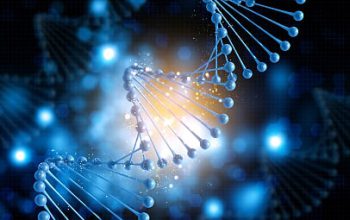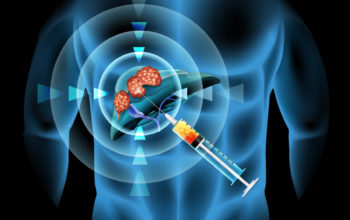
Date: 6th July 2021

Wearable biosensors have gained huge traction due to their potential for non-invasive health monitoring. They are used to detect the presence or concentration of biological analytes, such as biomolecules, biological structures or microorganisms and are a means of extracting real-time physiological parameters indicative of health status. Synthetic biology has revolutionised science in recent years, in part due to its unprecedented control of biological systems. And, whilst genetically encoded sensors have been incorporated into bench-top diagnostics, their inclusion into wearable devices is severely limited as the living cells, bacteria or biomaterial which constitutes the sensor, have to be sustained for long periods in an inhospitable and wearable environment. Now, researchers have generated lightweight, flexible wearables functionalised with cell-free synthetic circuits, including CRISPR-based tools, that can detect biomolecules, and when incorporated in to a face mask can detect SARS-CoV-2 within 90 minutes.
The ability to retain viable and functional wearable sensing systems based on living cells is highly complex as they must sustain life for example by nutrient delivery, waste extraction, temperature and gas regulation. One alternative is to exploit cell-free synthetic biology reactions, which are self-contained abiotic chemical systems, which contain all the biomolecular component required for transcription and translation. These types of systems have already been achieved using freeze-dried shelf-stable components on porous substrates. Layering on to this has been the inclusion of genetically engineered circuits, encoded in DNA or RNA, these freeze-dried, cell-free (FDCF) reactions are then activated by simple rehydration. Whilst, these technologies have produced simple, inexpensive paper-based nucleic acid diagnostics for example, they have yet been used to created practical wearable biosensors.
Now, researchers at the Wyss Institute for Biologically Inspired Engineering, Harvard University, US, led by James Collins have embed synthetic biology reactions into fabrics, such as CRISPR, creating wearable biosensors that can be customised to detect pathogens and toxins and alert the wearer. By integrating the technology into a standard face mask, it can detect the presence of SARS -Cov-2 in a patient’s breath within 90 mins, at a level of accuracy comparable to current gold standard tests, such as polymerase chain reactions (PCR).
In 2015, the Wyss researchers had first applied their technology to address the emerging Zika virus outbreak, pioneering the use of a paper-based synthetic gene network to detect the virus. It combined two novel technologies the first – cell-free synthetic biosensors that detected the presence of pathogen-derived RNA molecules coupled with a detection event, a coloured or fluorescent indicator protein, and secondly – the embedding of the biosensors in a freeze-dryable paper for long-term non-refrigerated storage.
Now, the team wanted to translate this technology in to a wearable device, so they methodically tested embedding the system in to more than 100 different kinds of fabric. They designed and validated various wearable FDCFs (wFDCFs) for small molecule, nucleic acid and toxic detection, integrating the sensors into flexible multi-material substrates such as silicone elastomers and textiles. They included genetically engineered components, including toehold switches, transcriptional factors, riboswitches, fluorescent aptamers and CRISPR-Cas complexes.
Colorimetric genetic circuit wearables
Modular colorimetric genetic circuits could be incorporated into bracelets, and the team used four different synthetic biology biosensors with lacZ as the output, these successfully detected anhydrotetracycline, Ebola virus RNA and theophylline with a visible change in colour with ~40-60 mins after exposure.
Fluorescent and fibre optic devices
Next, the team trialled fluorescent wFDCF devices with inter-weaved fibre optic detection to enhance the sensing capabilities. Upon activation by fluid splashing, target molecule detection would activate superfolder green fluorescent protein (sfGFP). Here, the team successfully sensed theophylline, HIV and Borrelia burgdorferi the bacteria responsible for causing Lyme disease. Further testing to assess the platform for the detection of chemical threats such as organophosphate nerve agents used in chemical warfare and the pesticide industry were also performed, and showed rapid and sensitive sensing of such agents.
CRISPR-based wearables
CRISPR-based biosensors are highly sensitive, have single base-pair resolution and a rapid ouput, ideal characteristics for the wFDCF platform. The team therefore, integrated CRISPR-based specific high-sensitivity enzymatic reporter unlocking (SHERLOCK) sensors into the fluorescence wFDCD system. They designed gRNAs against three common resistance markers in Staphylococcus aureus. The system displayed detectable signals within 56–78 min with femtomolar limits of detection, rivalling the detection via gold standard techniques such as quantitative PCR. The CRISPR-xFDCD system translated to a real-time monitoring of environmental exposure and biohazard detection by incorporating multi-sensor arrays into a wearable jacket.
As this work was being undertaken the current COVID-19 pandemic struck the world. The team saw this as an opportunity to contribute to the global effort to fight the virus, and decided to integrate the wFDCF into face masks to detect SARS-CoV-2.
CRISPR-based face mask biosensors
The face-mask sensor contained four modular components: a reservoir for hydration, a large surface area collection sample pad, a wax-patterned µPAD (microfluidic paper-based analytical device) and a lateral flow assay (LFA) strip. The device saw three different freeze-dried biological reactions sequentially activated by the release of water from a reservoir via the single push of a button, able to sense SARS-CoV-2 on the breath. The first reaction lysed the SARS-CoV-2 membrane, the second was an amplification step using a reverse transcription–recombinase polymerase amplification (RT-RPA) reaction zone containing a customised isothermal amplification reaction developed to target a nonoverlapping region of the SARS-CoV-2 Spike (S) gene. Lastly, the final reaction used CRISPR-based SHERLOCK technology to detect any Spike gene fragments. Here, the presence of SARS-Cov-2 derived amplicons, activated Cas12a which then cleaved a labelled-probe into two smaller pieces. A simple colorimetric LFA strip was able to detect probe cleavage if present, with a similar visual output to the currently used LFA for COVID-19.
From activation of the face-mask sensor to a final readout only took ~1.5 h, and the limit of detection (LOD) was 500 copies of SARS-CoV-2 (in vitro transcribed RNA) which matched the World Health Organization-endorsed gold standard RT-PCR assays. It was also validated using a precision lung simulator attached to a high-fidelity human airway model.
Unlike other nucleic acid tests, the SARS-CoV-2 face-mask sensor required no power source, operated autonomously without liquid handling, was shelf-stable, functioned at near-ambient temperatures, providing a visual output in under 2 h, with no specialised training or equipment required.
Conclusions and future applications
The team here have shown that their wFDCF platform is highly sensitive and effective as a wearable biosensor, it is a shelf-stable and genetically programmable, modular system which makes it highly flexible and adaptable. In the context of this publication, the team generated measurable colorimetric, fluorescence or luminescence outputs upon exposure to relevant real-world targets such as MRSA, Ebola virus, SARS-CoV-2 virus or environmental risk factors such as chemical warfare agents or pesticides.
This represents the first wearable technology to detect viral or bacterial nucleic acid signatures in fluid samples at ambient temperatures, which rivals the sensitivity of traditional laboratory tests. The device could be integrated into a variety of garments, and was compatible with wireless sensor network, providing real-time dynamic monitoring with the readout available through custom smartphone applications.
Biosensors are rapidly accelerating technology. We have recently seen a new EV-Chip biosensor that detects exosome cancer and aging biomarkers, using electronic graphene field-effect transitors (gFET). Similar technology has also been used to generate the world’s first ‘bio-electronic tongue/nose’ which harnesses the power of gFETs with synthetic insect odorant receptors to detect airborne and liquid-based toxins, and diagnose disease from volatile organic compounds in almost real-time. Other ultra-sensitive biosensors can detect nucleic acids using crumpled graphene and are able to detect cancer markers in patient blood or serum.
Although not wearable these technologies have huge potential to diagnose disease and pathogens. However, there is also progress in the wearable sensor field, such that battery-free, fully self-powered wearable system can dynamically monitor key sweat biomarkers. Precision medicine is also being accelerated by wearable patches for at-rest sweat monitoring for diseases such as Parkinson’s and diabetes.
Where this wFDCF platform differs is that is combines wearables with biosensors in such an adaptable manner. The team envisage their devices integrated into warfighters or first responders clothing, for personnel that operate in environments where chemicals or biological threats are suspects. Clinician, health workers or researchers could wear wFDCF-enabled lab coats or gowns, providing alerts of infectious diseases. It is not hard to see in the current climate that the SARS-CoV-2 face mask would be a highly valuable sensor-enabled personal protective equipment for patients or workers in hospitals or even those for those that are vulnerable in the community.
The team are now actively searching for manufacturing partners who are interested in enabling the mass production of the face mask diagnostic for use during the COVID-19 pandemic, as well as for detecting other biological and environmental hazards.
For more information please see the press release from the Wyss Institute
Nguyen, P.Q., Soenksen, L.R., Donghia, N.M., Angenent-Mari, N.M., de Puig, H., Huang, A., Lee, R., Slomovic, S., Galbersanini, T., Lansberry, G., et al. (2021). Wearable materials with embedded synthetic biology sensors for biomolecule detection. Nature Biotechnology.
https://doi.org/10.1038/s41587-021-00950-3


